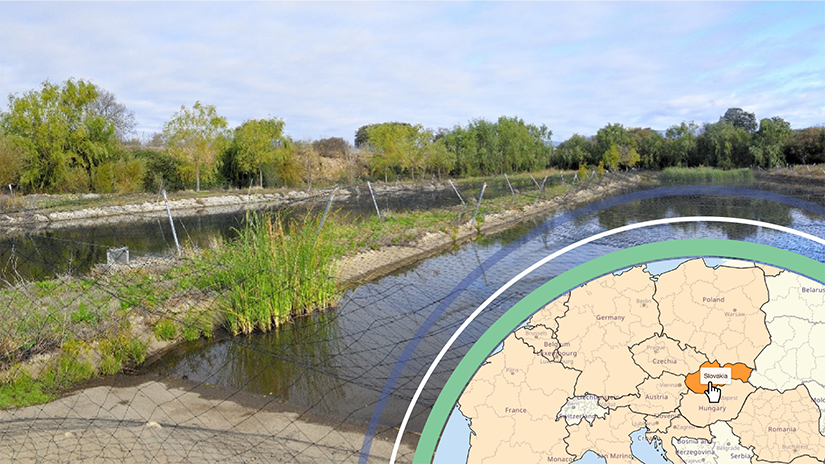Background information

Type of species farmed
Rainbow trout (Oncorhynchus mykiss), North African catfish (Clarias gariepinus) and common carp (Cyprinus carpio).
Source: 2024, STECF
Type of production method
With no direct access to the sea, aquaculture activity in Slovakia is limited to freshwater farming. The following main production methods were used in 2022:
Sector’s size (production and consumption)
Production (2022)
2.6 thousand Tn; 7.8 million € (2024, STECF)
Consumption of fishery and aquaculture products (2022)
10.36 Kg per capita
Variation in consumption (2022/2021)
0.4% (2024, EUMOFA)
Source: 2024, STECF & EUMOFA
Impact of aquaculture in the country’s economy, food market and labour market
- Low impact in the country’s economy. However, aquaculture contributes to the food security of the Slovak Republic and to reducing the import of fish into Slovakia. Aquaculture creates a lower carbon footprint compared to other livestock farming.
- In terms of marketing and final placing of products on the market, fish and trout production can be distinguished between the production of fish for direct consumption and the production of stock used in aquaculture for further rearing or restocking fishing grounds.
- Most fish are marketed fresh with the large proportion, mainly carp, sold live. The marketing of fresh carps is uneven as about 80 percent of production is sold in December during the Christmas season.
- Unlike trout, which is dominated by the production of fish for direct human consumption, fish production for restocking fishing grounds is now more important in the pond industry. Production from RAS is mainly directed at the production of fish for human consumption and, to a lesser extent, for restocking fishing grounds.
- Most aquaculture businesses can be classified as micro-enterprises (often family-run, which achieve small local market-oriented production). However, small enterprises and several medium-sized enterprises account for a decisive share of total aquaculture production. The existence of undertakings whose main activity is not aquaculture but, among other activities, are also involved in aquaculture.
- Given the size of the aquaculture sector, its potential production and current market prices, most businesses (particularly small and micro) are in a difficult economic situation and their ability to generate own resources for investment is limited.
- Ponds and farms are mainly located in rural areas, where they create employment opportunities for both family members and rural residents.
Source: MNSPA
Challenges and opportunities
- Spread of infectious diseases.
- Decline in sales of live fish in the pre-noon time period, less interest in carp in the young generation.
- Lack of trained people interested in working in the sector.
- Water — deteriorating qualitative and quantitative indicators related to climate change, pressure from other sectors on water use.
- Restrictions by nature protection authorities.
- Uncertainty about the relevant compensation for damage caused by fish predators.
- Low economic return on investments in the aquaculture sector.
- Uncertainty in the guarantee of authorised water abstractions for fish farming.
- Insufficient knowledge of pollution of the aquatic environment.
- Reduction of the production capacity of water reservoirs (fisheries) due to sediment migration.
- Insufficient capacity for quarantine of live fish from imports.
- Transfer of land of unknown owners and land owned by the State to the Statistical Office of the Slovak Republic.
- Spread of invasive alien species of aquatic organisms.
- Non-productive functions of ponds and aquaculture ecosystem services.
- Possibility of using funds from the FOP 2021-2027.
- Targeted marketing to increase freshwater fish consumption and build a positive image of the sector.
- Cross-border cooperation with research organisations in neighbouring countries.
- Increase in fish production in existing plants.
- Construction of new production capacities (including RAS).
- Increase in on-farm sales of fish.
- Introduction of monitoring of water quality on farms, investments to increase fish welfare.
- Innovation, use of renewable resources, use of geothermal water.
- Income diversification.
- Lifelong learning for workers in the sector.
- Establishment of a producer organisation.
- Implementation of the new NSPRA 2030 targets.
- Minimising negative environmental impacts of aquaculture.
- Unlocking the potential of organic aquaculture.
- Improving working conditions and safety at work of employees.
- Modernisation, extension, construction of non-productive parts of farms and labour.
- Support for start-up breeders and processors, family firms of local interest.
- Harnessing the growing purchasing power of the population to increase consumption of freshwater fish.
- Protecting farms from fish predators.
- Regular publication of basic statistics on the aquaculture sector.
Source: MNSPA
Employment and number of enterprises
385 permanent and 354 seasonal workers were employed in the aquaculture sector in 2021.
119 aquaculture enterprises in 2020.
Source: 2021, Statistical Office of the SR
Multi-annual National Strategic Plans for the development of sustainable Aquaculture
Relevant Authorities
Applicable Legislation
- Ordinance on animal health requirements for aquaculture animals and products thereof, and on the prevention and control of certain diseases in aquatic animals
- Act No. 39/2007 Coll. on veterinary care as amended
- Act No. 194/1998 Coll. on animal breeding and amending Act No. 455/1991 Coll. on trade licencing of natural persons (Animal breeding act) as amended
- Act No. 364/2004 Coll. on water and amending Act No 372/1990 Coll. on offenses (Water act) as amended
Applicable Procedures
National associations and networks
Contact Details
Section of Agriculture, Ministry of Agriculture and Rural Development of the Slovak Republic
Dominik Škoda, Chief State Adviser
- Telephone number: +42 125 926 6577
Uploads
Summary in English of the "Published National Strategic Plan on Aquaculture" for Slovakia
